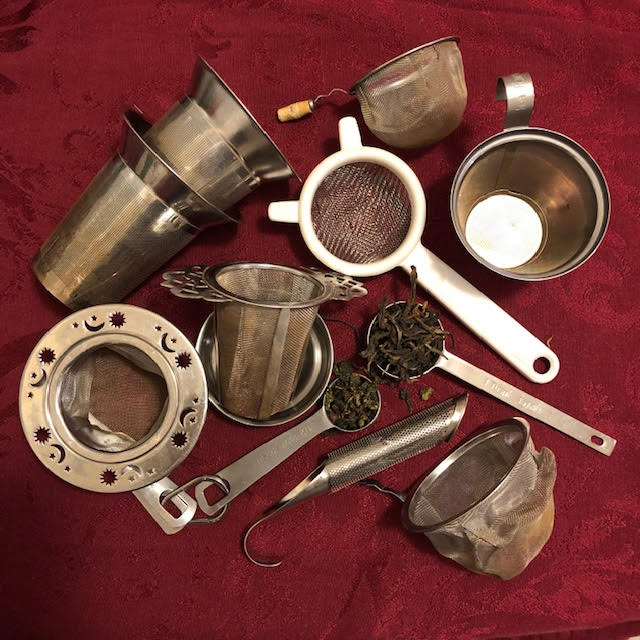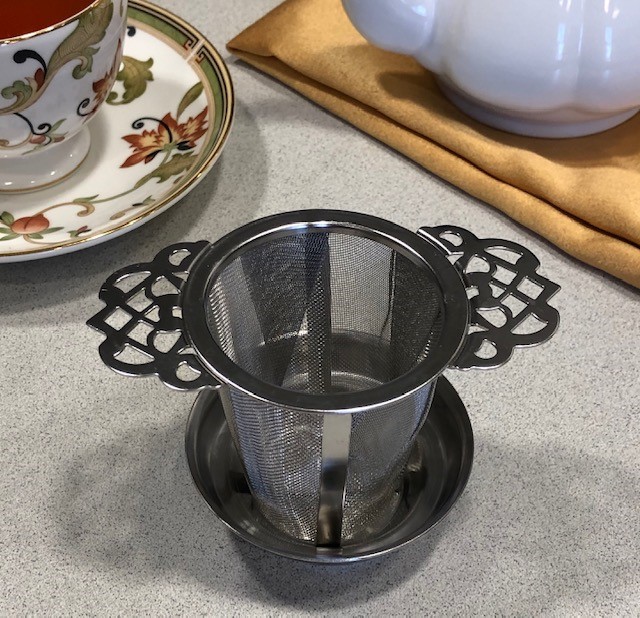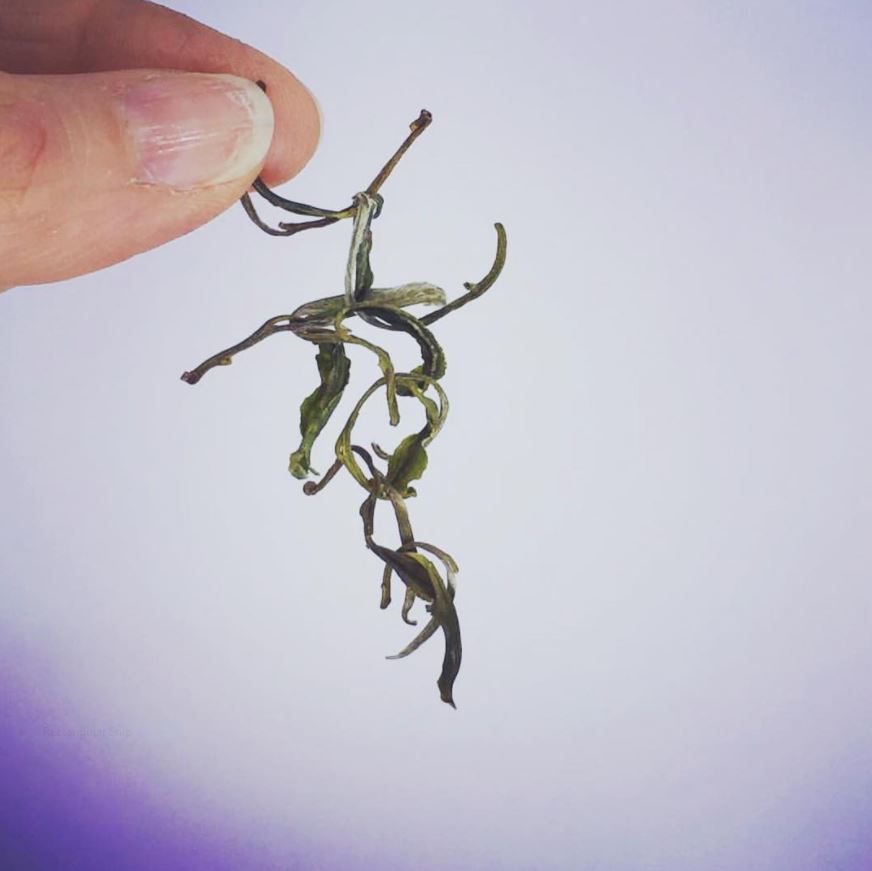What are the practical considerations to start using loose leaf tea? It’s relatively easy to use once you know a few basics! This post provide advice on how get started with loose leaf tea.
It explores: what to use to steep loose leaf tea, how much tea to use per serving, and how long to steep.

The first issue practical issue to start using loose leaf tea is figuring out what to use to steep it. Without the practicality of a tea bag, after all, this decision requires a little thought.
The principles that guide my infuser recommendations are: plenty of space for the tea leaves to expand and infuse, ease of use and cleaning, and versatility.
What to Use to Steep Loose Leaf Tea
There are so many accessories you can use to steep loose leaf tea. But, to begin, it’s best to keep it simple. You can use items you probably already have at home–two mugs and a small strainer. In this method, you could steep the tea leaves in one mug (or even in a glass measuring cup), and then decant through the small strainer into another mug. So easy!
If you are willing to invest in an accessory specifically designed for loose leaf tea, there are several good options to start. You could purchase a mug with a built-in infuser. I enjoy infuser mugs. Beware though, if the infuser is porcelain or glass–and if you are like me–you will break the infuser insert before you break the mug. I don’t know why, but I always end up with a cracked infuser well before anything happens to my mug. The other downside to the built-in infuser is versatility. Will it only work for that mug?
Another option is to use a metal infuser basket. This is my top recommendation for getting started with loose leaf tea. Good water transfer, easy cleaning, versatility, and durability are the advantages of metal infuser baskets. The most convenient infuser baskets, in my experience, have fine stainless steel mesh for maximum water transfer and excellent straining capabilities. As you can see in the picture, below, my favorite metal strainer is narrower at the bottom. It’s also tall, with a wide top. This design makes the infuser able to rest in or on every mug in my cabinet while also being able to fit low enough into my one- or two-serving teapots to do its job. (If the strainer is too wide at the bottom, it won’t fit low enough into most teapots for the tea to be in full contact with the water.)

You can find the infuser above at the Clipper Ship Tea Company. Happily, it’s very affordable. I show and compare different basket infusers in this short video.
Other Infusion Methods
A final–and fun–option is a silicone tea infuser. These come in so many fun and colorful options. I completely get the appeal. I tend to shy away from silicone infusers, however, because I find them harder to clean. The holes in these infusers are also often smaller than ideal to get the best flow of water to the tea leaves. And, sometimes they are too small to allow bigger leaves the space they need to expand.
I don’t recommend tea ball infusers or tea infuser spoons. They look elegant. But, the tea ball infusers are often hard to open. (I think of them as “fingernail-breakers.”) Also, neither type usually offers enough space for loose leaf tea to properly expand and infuse to its full potential.
How Much Loose Leaf Tea Should I Use?
Although being able to control how much tea you use per serving is a wonderful advantage of starting to use loose leaf tea, it also presents a challenge at first. Without a tea bag to guide you, how much do you use?
Loose leaf tea can range in size from very small to (relatively) huge tea leaves. The volume of the tea and the weight of the tea can vary dramatically. The good news is most packages of loose leaf tea contain recommendations for how much leaf to use. In general, it’s usually somewhere between 1.5 teaspoons and 1 Tablespoon of loose-leaf tea per 8 ounces (240 ml) of water. For smaller tea leaves or leaves in compact “pearls,” it’s a good bet to start with a smaller quantity. Larger leaf teas or teas that are blended with herbs, spices, etc., will often have recommendations on the higher end. A good strategy is to follow the package recommendations and then experiment to find the amount that is perfect for you.

How Long Do I Steep Loose Leaf Tea?
There is, alas, no one-size-fits-all recommendation for steeping loose leaf tea. In general, smaller and broken leaves will infuse faster. (That’s one reason the infusions of ground or small tea leaves in the most popular tea bags get strong so quickly.)
Like with the amount of tea, most packages of loose leaf tea will come with recommended steeping times. It’s good to start with that and then experiment.
There’s one maxim that I follow that almost always serves me well. If you would like a stronger brew of loose leaf tea, try more tea and the same steep before you try the opposite. Longer steeps of tea tend to bring out more of the bitter and astringent qualities. So, unless that’s your goal, start by trying more loose leaf tea.
Your Relationship to Tea May Change
Tea bags are convenient and have their advantages. (Who doesn’t like to admire a cute tea tag, for example?) Starting to use loose leaf tea has advantages, too. To only name one–but a big one–you may notice your relationship to tea change.
Accessing tea without a bag separating it from you means you can see the tea leaves more clearly and better detect the aroma of the dry leaves. Tea leaves can be beautiful and fascinating in their variety of shapes, colors, and aromas.
Being able to touch the leaves is also a pleasure that puts you in a more direct relationship with the tea. The enhanced sensory experience and immediacy are wonderful advantages of switching to loose leaf tea. The change might introduce you to the poetry of tea.

Do you have other questions or experiences about starting with loose leaf tea? If so, I invite you to share in the comments.
Interested in a side of history with your cup of tea, my post about the “Boston Tea Party” may interest you. If you would love how to make frothy milk for delicious tea lattes, this post “How to Froth Milk on the Stovetop” may be helpful.
Stay Connected?
Subscribe to my monthly newsletter for tea lovers, Tea Infusiast News!
